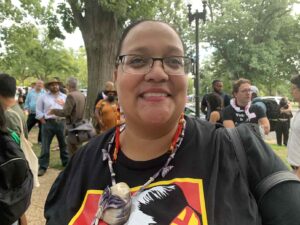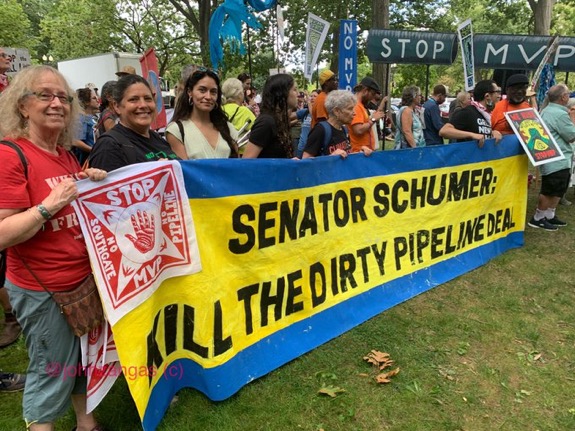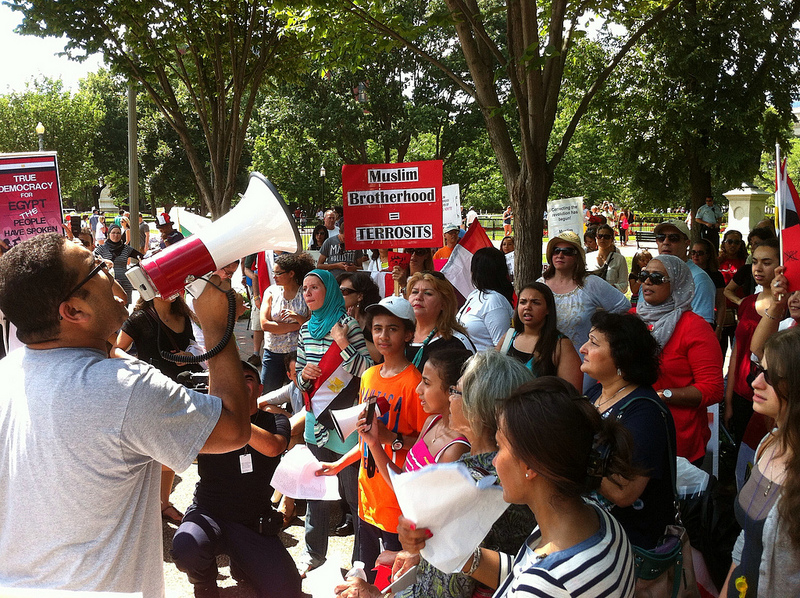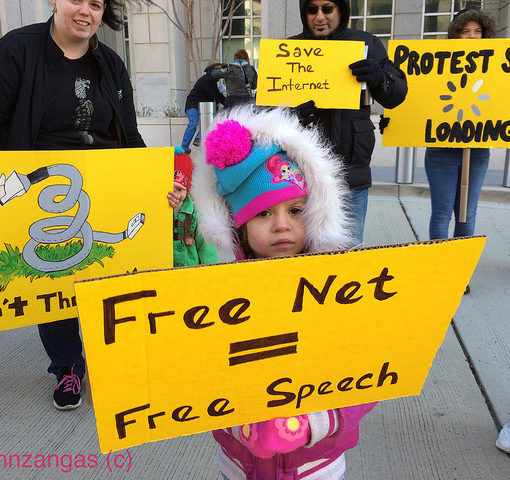Washington DC—A coalition of dozens of environmental groups from around the country, led by grassroots community organizers, lobbied at Congress and at the White House on Thursday warning President Joe Biden that his agreement with Senator Joe Manchin would further worsen the global climate emergency. They assembled for a rally near the U.S. Capitol in the afternoon where speakers from front-line communities bore witness to the destructive effects the fossil energy industry was having on their health, water, land, and livability. Many held banners and signs identifying their community and their struggle. Nearly 1000 took part in the day’s long event.
Speakers came from Alaska, Florida, North Carolina, Michigan, New York, and many states in between to tell of effects the fossil energy industry was having on their front-line communities. One by one speakers told it was more often than not the pipelines, methane powered plants, fracking wells, incinerators, and supporting infrastructure was being built in or near poorer communities, minority urban zones, and indigenous communities with the least amount of resources and political leverage to challenge or organize against such projects.
Environmental Organizers’ Voices of Resolve
William J. Barber, III, an environmental and climate justice scholar and advocate, who currently works as a Strategic Partnerships Manager at the Climate Realty Project, spoke of the relative recent successes the climate justice movement was having in getting Federal action on the climate action. He said that if the Appalacian Resistance climate justice movement was able to get climate legislation into the Inflation Reduction Act, the movement could do even more if it was at its full strength.
Barber, who is from North Carolina and has previously worked with his father, William Barber, II, on the Poor People’s Campaign, told of his mixed family heritage of African American and Tusca Roy indigenous roots and the impact fossil energy projects had on such communities. He said that voices from such communities were pivotal in moving climate justice forward and such voices needed to be in the rooms with energy giants so they could understand what impact their projects were having on those communities.
“Just a few months ago federal climate action seemed like an impossibility but thanks to the tireless efforts of the voices and leaders like you all that refused to stop we forced federal climate action back into the conversation,” he said.
But he warned that there was no time to rest and much more needed to be done. “Our movement, our communities, and our planning is in the fight for its life. We must stand against any attempt to fast-track projects that make this climate crisis worse.” He mentioned the interstate Mountain Valley Pipeline and the fast-track initiative agreement between Senators Manchin and Schumer as one example of an “attempt to offer up our communities as a sacrifice zones. We cannot have climate solutions without justice justice,” he said.
The Mountain Valley Pipeline project is a 304 mile, 42 inch diameter methane pipeline being built between Northwest West Virginia and Virginia that will process fracked methane gas to points South for national use and for export.
Crystal Cavalier, from the Occaneechi Band of Saponi Nation, came to the Appalacian Resistance action to tell of the impacts of the MVP on her community and people. “The MVP is coming through our lands and digging up our burial grounds. Our indigenous people have been made invisible for so long that nobody knows and we have to speak up,” she said.
Another participant in the action was Steve Norris, an environmentalist who has worked with Beyond Extreme Energy (BXE) and North Carolina Alliance to Protect Our People and Places We Live (NC APPPL), both of which are grassroots organizations. The NC APPPL previously helped fight the Atlantic Coast Pipeline, another interstate methane gas project undertaken by Dominion Energy and Duke Energy and helped stop its construction in 2020.
The MVP will damage farms and communities in Appalachia,“ said Norris, who works on environmental issues in North Carolina and often travels across the country supporting other environmental groups.
Norris said the MVP will enable Duke Energy to build and fuel 50 methane gas turbines to generate electricity and blow efforts to reduce carbon output at a time when global heating is already having catastrophic consequences across the country and the world.
“This pipeline is like having 20 million additional cars on the highways and we just can’t afford it,” he said. “We just can’t afford another pipeline of this magnitude.” Norris pointed out that although the climate emergency outlook was dim that we could not gove up hope ar stop organizing and fighting projects like the MVP. “The news is not good but on the other had its not good to give up hope because if we give up hope we lose.”
Tara Vamos, a front-line community organizer with Water Watch New York State, said that there is already so little community input when it comes to fossil energy projects. “The deal cut between Senator Schumer and Senator Manchin would gut policy protections in the National Environmental Protection Act (NEPA). It would gut the Clean Water Act and that would mean that twenty projects a year would get green lit without community input.”
Vamos was resolute that she and her organization would not stand by while projects like the MVP cut through communities. “Its time to get serious about people’s rights, indigenous sovereign rights, and the rights of people living in these communities.”
Climate Disruption Accelerating Globally
The effects of the deteriorating global climate are becoming more and more evident as the climate worsens from continuing use of fossil fuels as an energy source—coal, oil, and methane—which are all carbon based energy sources. As carbon has increased in the atmosphere climate has gotten much worse, much more quickly, than even the scientists were projecting just a few decades ago. While claims of climate and environmental degradation are relative, there can be no mistaking the environment faces worsening waves of heat as a result of carbon in the atmosphere released by burning fossil fuels.
For those few still doubting there is a climate emergency, one only need look at headline news reports of drought, flooding, fires, and historic heat waves from around the world. It is clear that the time to act is quickly running out and that tipping points—major self-perpetuating climatic events on a global scale—may soon begin to take over the chain of climate events and make moot any action humanity takes to mitigate global heat.
In Pakistan, where 1/3 of the country, nearly 35 million, were displaced by flooding since June of this year. The flooding seen there requires world countries to mobilize assistance said António Guterres, UN Secretary-General.
The Secretary-General traveled to Pakistan to view the devastation last week. During his remarks he drew a connection between the floods in Pakistan to climate disruption. “We need to stop the madness with which we are treating nature. According to the scientific community, we need to reduce emissions by 45 per cent until 2030. I’m not talking about the end of the century, I’m not talking about 2050, I am talking about now. Now is the time to reduce emissions. This will be essential in the discussions in Cairo of the [COP27]. But the fact is that we are already living in a world where climate change is acting in such a devastating way.”
In the U.S. midwest, where a decades-long mega-drought is getting worse, Lakes Powel and Meade have been reduced by 3/4 due to the drought, heat, and increasing demand due to drought. The flow of the Colorado River has been reduced by 20% leading to region-wide water restrictions. Seven States get much of their water from these sources. In California an unprecedented 90% of the State is under water restrictions.
A heat dome that lodged over California and nearby states over the last few weeks was responsible for toppling September temperature records across the region. The heat indices have contributed to the ferocity of large fires like the “Mosquito Fire” now having consumed over 50,000 acres as of September 11, and is still raging. This conflagration began on September 6 in the Sierra Nevada near Lake Tahoe and was reported to have induced its own weather pattern in the form of a pyrocumulous cloud resembling a swirling thunderstorm which reached the upper atmosphere.








